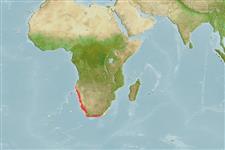Holocephali (Chimären, Seekatzen) (chimaeras) >
Chimaeriformes (Chimaeras) >
Callorhinchidae (Plownose chimaeras)
Etymology: Callorhinchus: Tautonymous with Chimaera callorynchus Linnaeus 1758 (but unnecessarily emended from -rynchus to -rhinchus: callum (L.), hard skin; rhynchus (L.), snout, referring to peculiar hoe-shaped proboscis. (See ETYFish); capensis: -ensis, Latin suffix denoting place: Cape of Good Hope, type locality. (See ETYFish).
More on author: Duméril.
Environment: milieu / climate zone / depth range / distribution range
Ökologie
seewasser demersal; tiefenbereich 10 - 374 m (Ref. 5578), usually 10 - 200 m (Ref. 3180). Subtropical; 17°S - 35°S, 11°E - 34°E
Southeast Atlantic: Namibia to the Cape and Natal in South Africa (Ref. 5578, 58304).
Length at first maturity / Size / Gewicht / Alter
Maturity: Lm 49.6 range ? - ? cm
Max length : 122 cm TL Männchen/unbestimmt; (Ref. 3180); max. veröff. Gewicht: 5.3 kg (Ref. 40637)
Kurzbeschreibung
Morphologie | Morphometrie
Rückenflossenstacheln (insgesamt): 1. An elephant fish with a hoe-like snout and arched caudal fin (Ref. 5578). Silvery or bronzy with brown markings on flanks and head; fin webs brown (Ref. 5578).
Found from close inshore and shallow bays to the slope (Ref. 5578). Feeds on small fish and a wide variety of invertebrates (Ref. 27121). Oviparous (Ref. 50449). Produces egg-cases that are spindle shaped, with broad horizontal flanges (Ref. 36731). This species is known to host on its gills monogenean parasites Callorhynchocotyle callorhynchi (Manter, 1955) (Hexabothriidae) and Callorhynchicola multitesticulatus Manter, 1955 (Chimaericolidae) on its gills (Ref. 124045, 124046). Sold commercially as 'silver trumpeter' (Ref. 3180) and considered a delicacy in southern Africa (Ref. 27121). Minimum depth reported from Ref. 7403.
Life cycle and mating behavior
Geschlechtsreife | Fortpflanzung | Ablaichen | Eier | Fecundity | Larven
Krefft, G., 1990. Callorynchidae. p. 117. In J.C. Quero, J.C. Hureau, C. Karrer, A. Post and L. Saldanha (eds.) Check-list of the fishes of the eastern tropical Atlantic (CLOFETA). JNICT, Lisbon; SEI, Paris; and UNESCO, Parisl. Vol. 1. (Ref. 7403)
IUCN Rote Liste Status (Ref. 130435)
Bedrohung für Menschen
Traumatogenic (Ref. 12484)
Nutzung durch Menschen
Fischereien: weniger kommerziell; Sportfisch: ja
Mehr Information
ReferenzenAquakulturAquakultur ProfilZuchtlinienGenetikElectrophoresesVererbbarkeitKrankheitenVerarbeitungNutrientsMass conversion
PartnerBilderStamps, Coins Misc.LauteCiguateraGeschwindigkeitSchwimmstilKiemenoberflächeOtolithsGehirngrößeSehfähigkeit
Tools
Zusatzinformationen
Download XML
Internet Quellen
Estimates based on models
Preferred temperature (Ref.
123201): 10.3 - 21, mean 16.2 °C (based on 200 cells).
Phylogenetic diversity index (Ref.
82804): PD
50 = 0.7500 [Uniqueness, from 0.5 = low to 2.0 = high].
Bayesian length-weight: a=0.00437 (0.00175 - 0.01086), b=3.12 (2.90 - 3.34), in cm total length, based on LWR estimates for this (Sub)family-body shape (Ref.
93245).
Trophic level (Ref.
69278): 3.5 ±0.52 se; based on food items.
Generation time: 21.3 ( na - na) years. Estimated as median ln(3)/K based on 2
growth studies.
Widerstandsfähigkeit (Ref.
120179): niedrig, Verdopplung der Population dauert 4,5 - 14 Jahre. (Fec assumed to be <100).
Fishing Vulnerability (Ref.
59153): High vulnerability (59 of 100).
Climate Vulnerability (Ref.
125649): Moderate to high vulnerability (50 of 100).
Nutrients (Ref.
124155): Calcium = 27.3 [7.3, 78.0] mg/100g; Iron = 0.819 [0.288, 3.576] mg/100g; Protein = 14.1 [11.0, 18.4] %; Omega3 = 0.255 [0.106, 0.572] g/100g; Selenium = 38.9 [8.7, 103.3] μg/100g; VitaminA = 6.42 [2.18, 18.02] μg/100g; Zinc = 0.549 [0.281, 1.037] mg/100g (wet weight);
